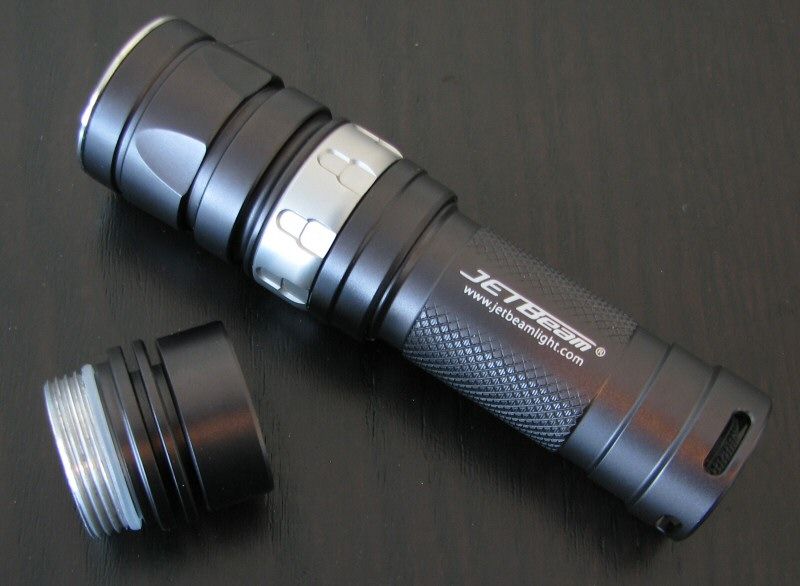
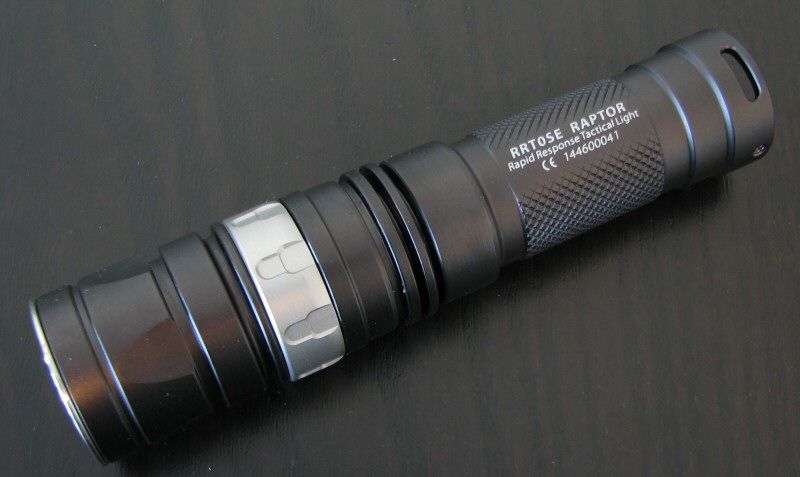
The RRT0-se is the latest version of the compact, continuously-variable 1xCR123/RCR model from Jetbeam, extendable to 1xAA/14500. Previously available as the RRT-0, this new specimen falls under the new "special edition" design from Jetbeam. Given its feature set, this makes the RRT0se a natural competitor to the Nitecore SRT3 and Sunwayman V11R. Unfortunately, I have not tested the original RRT-0, but I have previously reviewed the Jetbeam RRT-01, as well as the more recent RRT26 and BC25se.
For this review, I have a sample of the RRT0se recently supplied by gearbest.com.
Manufacturer Reported Specifications:
(note: as always, these are simply what the manufacturer/dealer provides – scroll down to see my actual testing results).
- LED: CREE XM-L2
- Max output reaches 730 lumens with an effective range of 155 meters
- Runtime: Low Mode: 45 hrs
- Beam Distance: 150-200m
- The rapid response control ring allows the user to easily select different brightness level
- Mode: 6 (Strobe; Turbo; Infinite Brightness Adjustment; Standby; Lowest; SOS)
- Battery Quantity: 1 x AA or RCR123A battery (not included)
- Reflector: Aluminum Textured Orange Peel Reflector
- Lens: Toughened Ultra-clear Glass Lens with Anti-reflective Coating
- Impact Resistance: 1.5m
- Flashlight Processing Technology: Aerospace Grade Aluminum Body with Anti-Scratching Type III Hard Anodization
- Body Material: Aluminium Alloy
- Stainless steel rapid response control ring for durability and reliability
- Stainless steel bezel protects the head and tailcap from drops and impacts
- Newly designed high efficiency broad voltage drive circuit
- Tailstand as a candle
- Impact-resistant accords with US MIL-STD-810F
- IPX-8 standard waterproof (2 meters)
- Specially designed for military, law enforcement, self-defense, hunting, search, rescue and outdoor activities
- Product weight: 0.084 kg
- Package weight: 0.15 kg
- Product size (L x W x H): 11.62 x 2.64 x 2.36 cm / 4.57 x 1.04 x 0.92 inches
- Package size (L x W x H): 15 x 8 x 4 cm
- Package Contents: 1 x Jetbeam RRT0-SE Cree XM-L2 730Lm 4 Modes Torch
- MSRP: ~$90
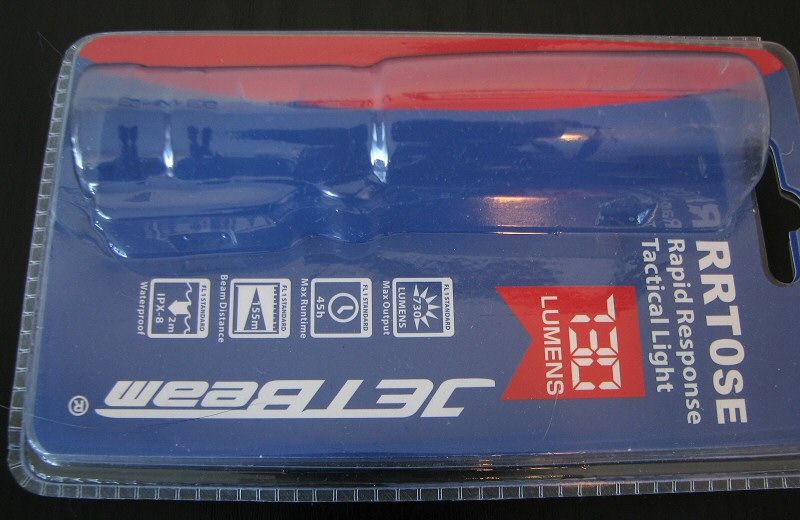
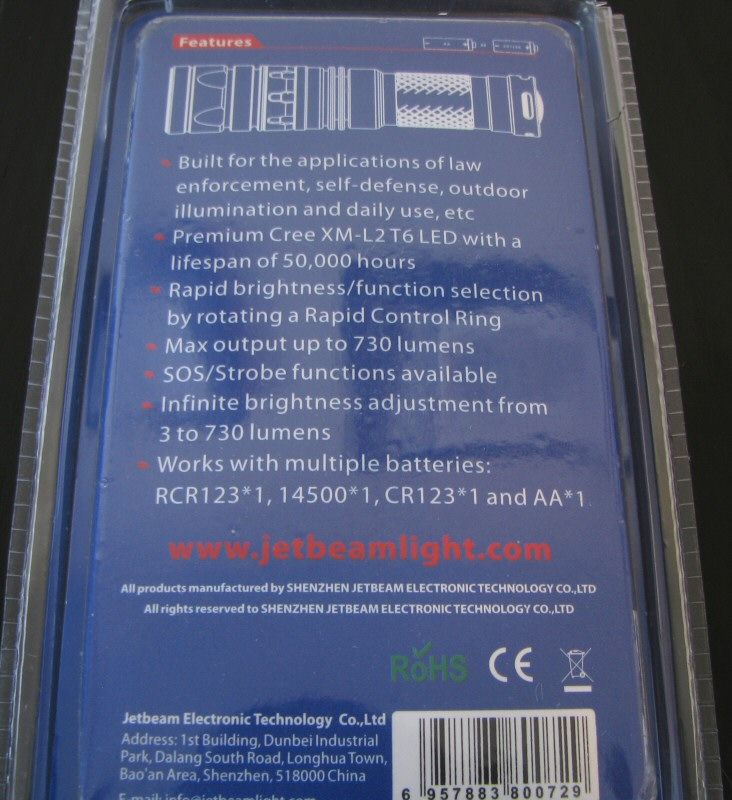
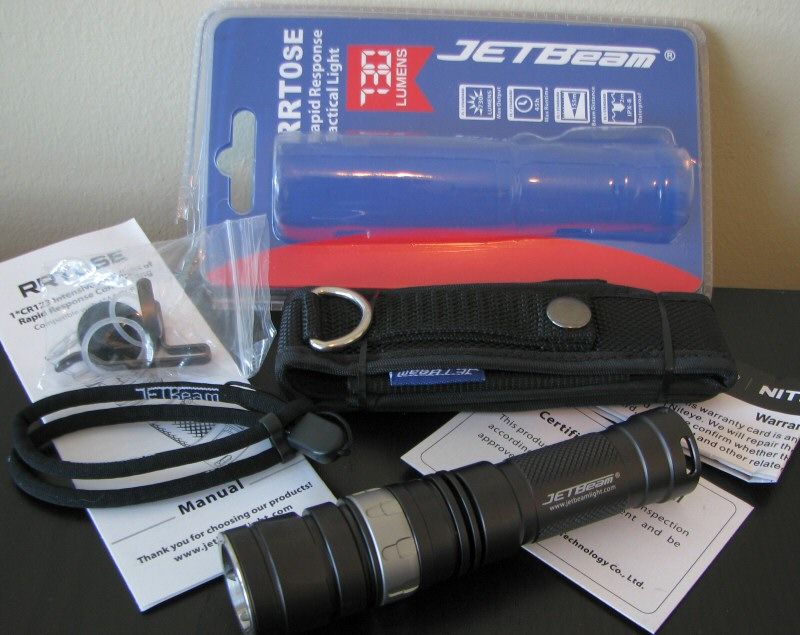
Packaging is similar to the Jetbeam RRT26 that I recently reviewed – a simple clear plastic container, heat-sealed. You have to cut open the plastic to access the interior. This is not my favorite style of packaging, but seems to be the new norm for Jetbeam. :shrug:
Included with the light (with removable AA extender installed) is a basic wrist lanyard, extra o-rings, spare switch boot cover, basic holster (with Velcro closing flap), reversible pocket clip, product insert and warranty card.
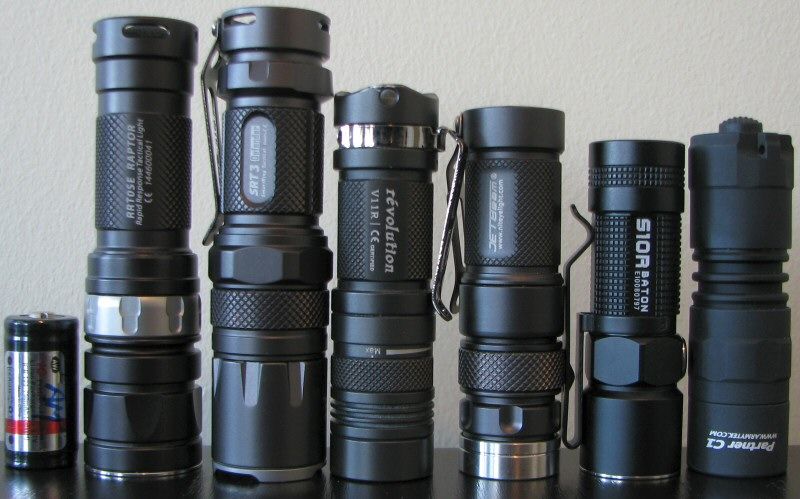
From left to right: AW protected RCR; Jetbeam RRT0se; Nitecore SRT3; Sunwayman V11R; Jetbeam RRT-01; Olight S10R; Armytek Partner C1.
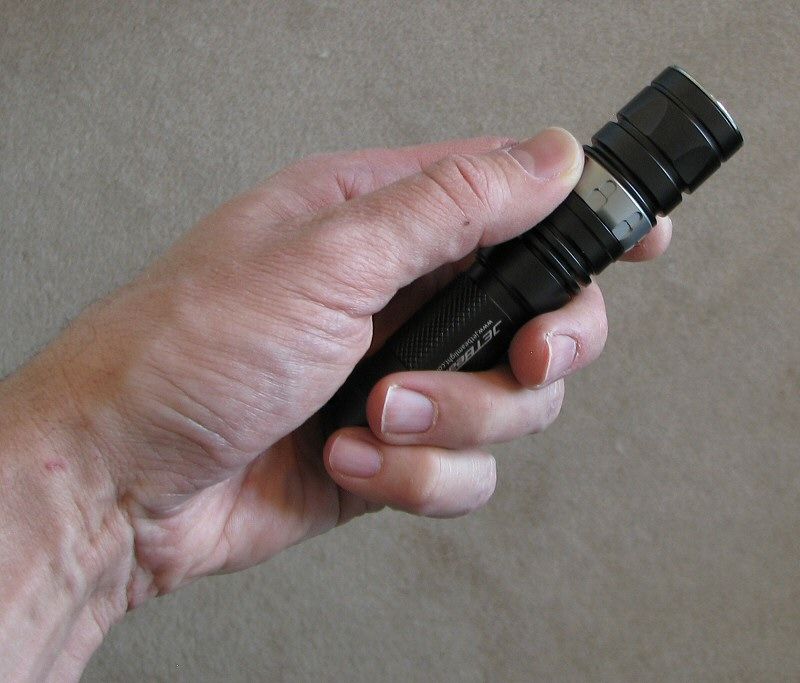
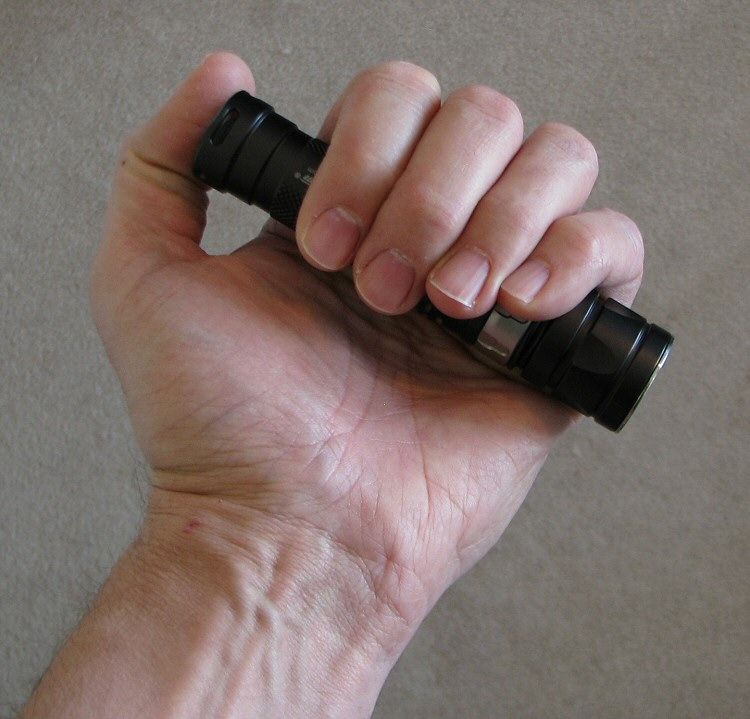
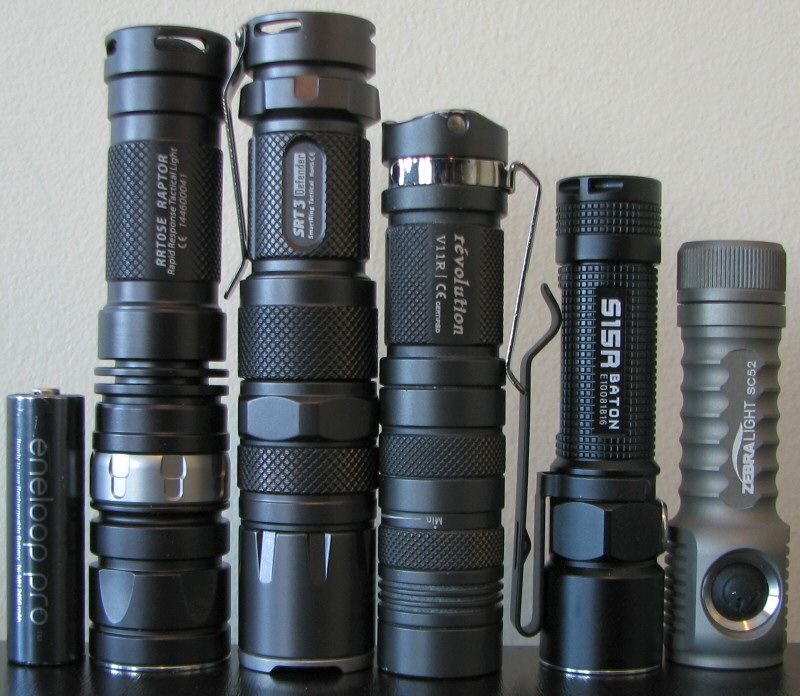
From left to right: Panasonic Eneloop Pro AA NiMH; Jetbeam RRT0se with AA extender; Nitecore SRT3 with AA extender; Sunwayman V11R with AA extender; Olight 15R; Zebralight SC52.
All dimensions directly measured, and given with no batteries installed:
Jetbeam RRT0se: Weight: 74.7g, Length: 98.7mm , With (bezel): 26.4mm
Jetbeam RRT0se (with AA extender): Weight: 83.4g, Length: 115.7mm , With (bezel): 26.4mm
ArmyTek C1 XM-L: Weight: 43.0g, Length: 80.2mm , With (bezel): 23.1mm
Lumintop ED11: Weight: 44.1g, Length: 83.7, Width (bezel): 21.8mm
Foursevens QTLC: Weight 36.4g, Length 84.1mm, Width (bezel) 22.1mm
Olight S10 (2013): Weight: 41.5g, Length: 70.8mm, Width (bezel): 23.2mm
Skilhunt DS10: Weight: 47.0g, Length: 76.1mm, Width (bezel): 24.0mm
Sunwayman V11R (no extender): Weight 50.5g, Length: 84.3mm, Width (bezel): 23.1mm
Eagletac D25C Clicky: Weight: 30g, Length: 76.0mm, Width (bezel): 20.0mm
Jetbeam PC10: Weight: 50.5g, Length: 93.6mm, Width (bezel): 22.6mm
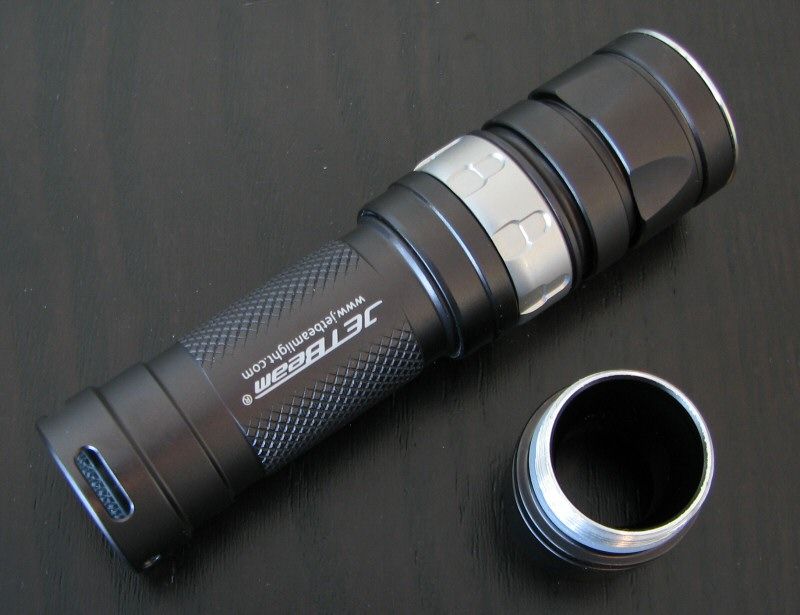
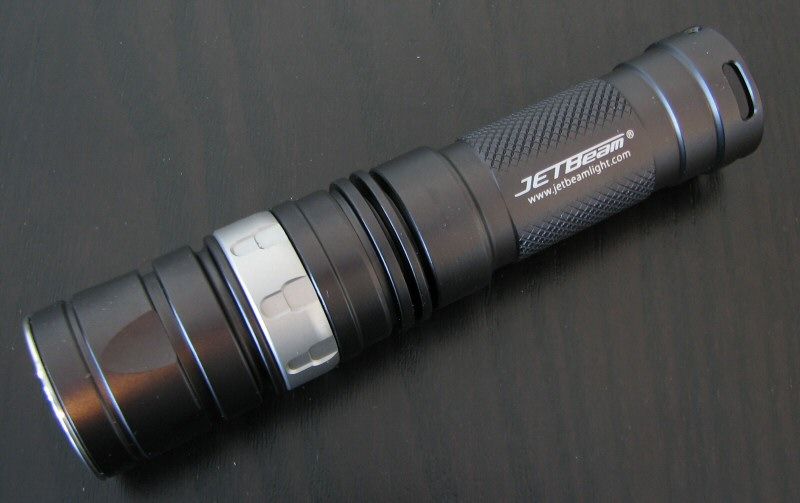


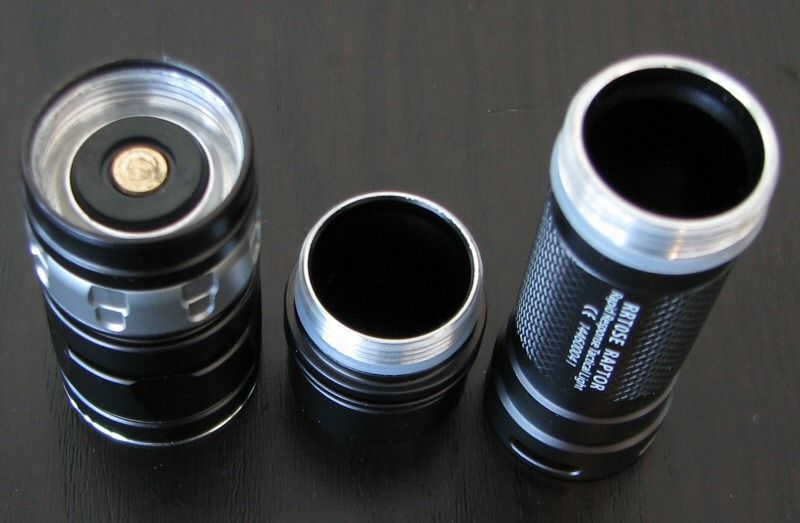
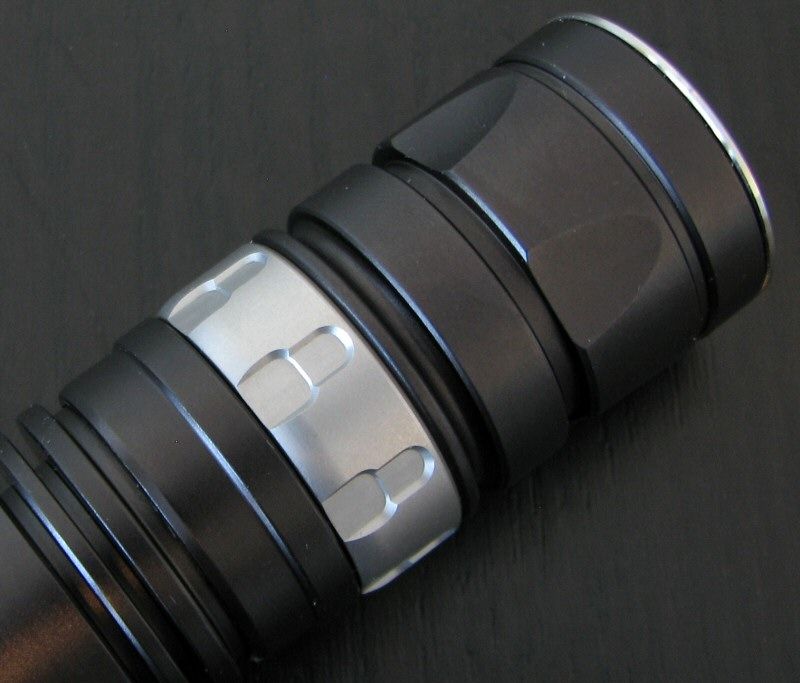
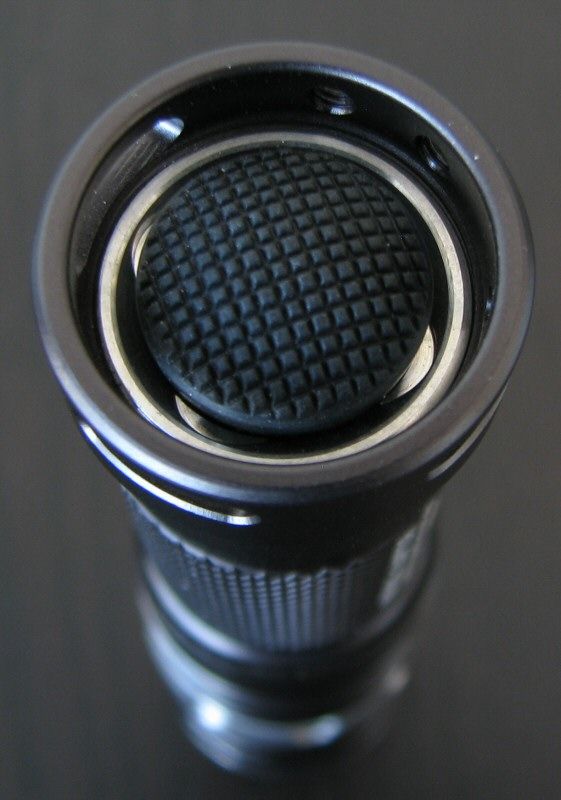
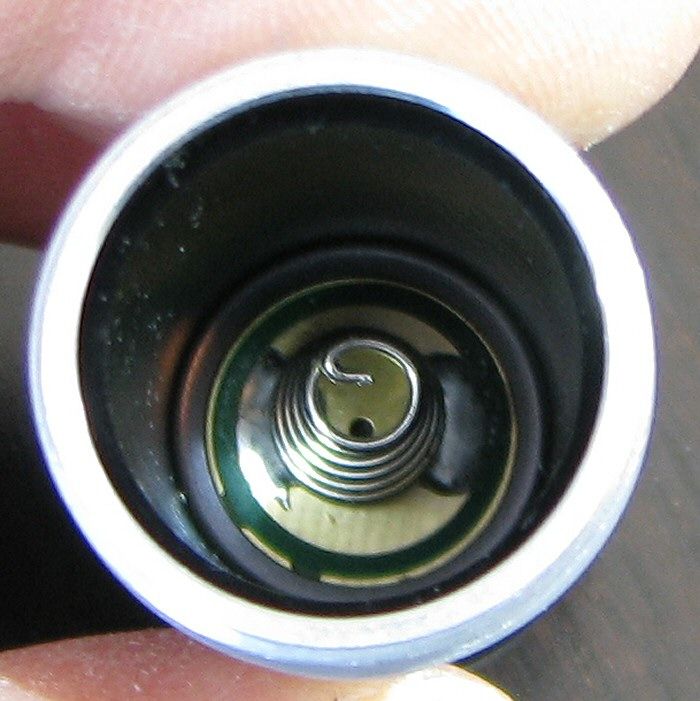
Physically, in both stock and AA-forms, the RRT0se is longer than the Sunwayman V11R - more like the Nitecore SRT3 in fact (though not quite as beefy). Anodizing is a rich, dark gray natural finish (one of my preferred colors, personally). Labels are clear against the dark background. Knurling is very mild, but the ridge detail helps with grip (there is also a removable pocket clip, which can serve as an anti-roll device).
The light uses a silver-colored aluminum control ring in the head, similar to the RRT26 that I recently reviewed. Feel is also similar – not quite as firm as I would like, but serviceable. Like the other Jetbeam lights, there are very clear "detents" that the RRT0se ring enters into before switching through the various output modes. There seems to be a mm or two turn required out of the standby detent before any light is produced (and the lowest level is higher than competing products). See my User Interface and testing results for further discussion.
The tail switch is a forward electronic switch. There is a built-up surrounding cover which allows tailstanding (and also somewhat restricts access to the switch).
Screw threading is a standard triangular cut, and is not anodized (i.e., no head lockout possible). Same goes for the AA extender piece, which fits in between the body and the head. Threads feel unusually "gritty" even after a cleaning – on both the main body and extender regions. :shrug: As with other lights with this feature, the extender piece has a narrower internal diameter, to prevent rattle of the thinner AA cells.
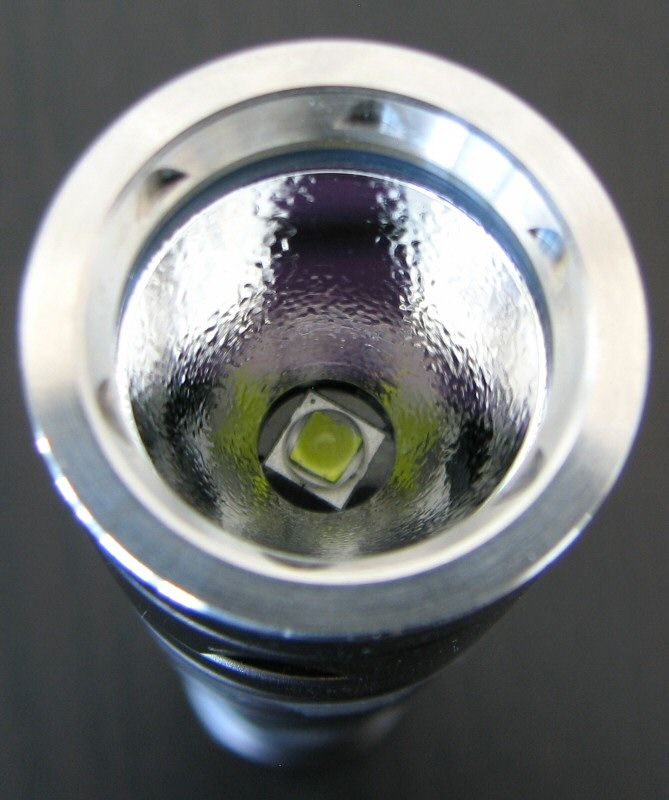
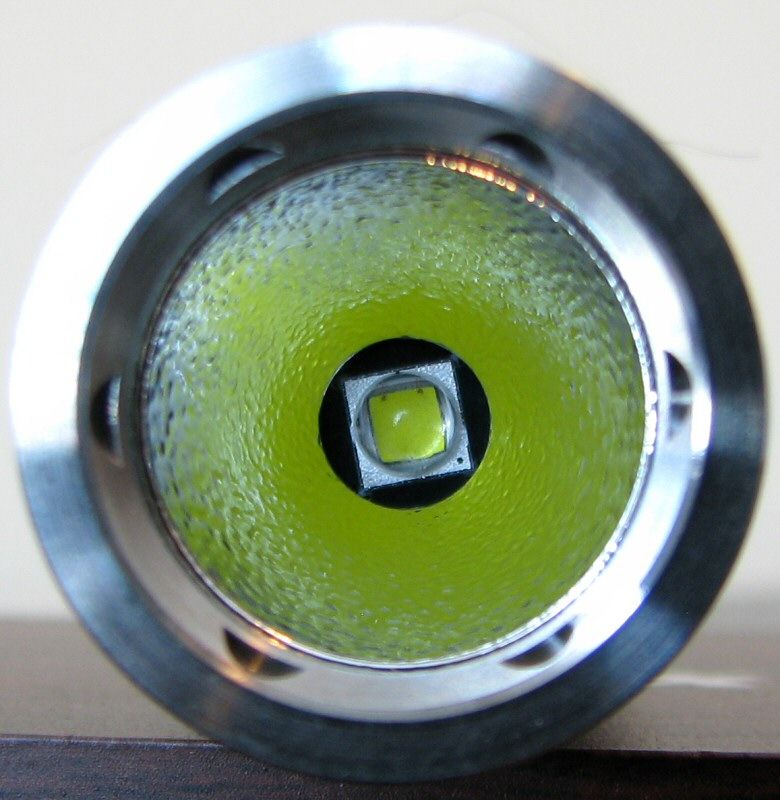
The RRT0se uses a standard XM-L2 Cool White emitter. The emitter was reasonably well centered on my sample, coupled with a light orange peel reflector. Please scroll down for beamshots.
User Interface
The RRT0se has a forward tailcap clicky - press and release for momentary on, click for locked on.
Mode switching is controlled by the magnetic control ring in the head. As previously mentioned, the RRT0se features a continuously-variable interface, as well as a couple of extra modes. Note that you can select your desired mode while the light is off, if you remember the sequence.
The various output modes on the ring are separated by very clear detents (i.e., the ring stays firmly in position, and needs a bit of force to move into the next mode). Starting at the far left (i.e., holding the light out in front of you, with the ring all the way counter-clockwise), as you turn the ring to the right (clockwise), you get the following outputs modes:
Strobe > SOS > Standby off > Continuously-variable ramp (>200 degree turn of the ring between detents) > Max.
Each mode is set in a clear detent of the ring (except for the continuously-variable ramp, which is between the Standby off and Max detents). There is a slight delay of a mm or two, coming out of the standby detent, before any continuously-variable light is produced.
Video:
For information on the light, including the build and user interface, please see my video overview below:
For all my videos, I recommend you have annotations turned on. I commonly update the commentary with additional information or clarifications before publicly releasing the video.
As an aside, if you want to get an instant notification for every new review that I post, you can subscribe to my YouTube channel. The vids go public at the same time as the reviews here on CPF.
PWM/Strobe
The RRT0se shows signs of pulse width modulation (PWM). It's a little unusual though, so let's go through two sets of conditions, starting with 3.7V Li-ion (14500), followed by 1.2V NiMH (AA).
RRT0se 14500 Max:
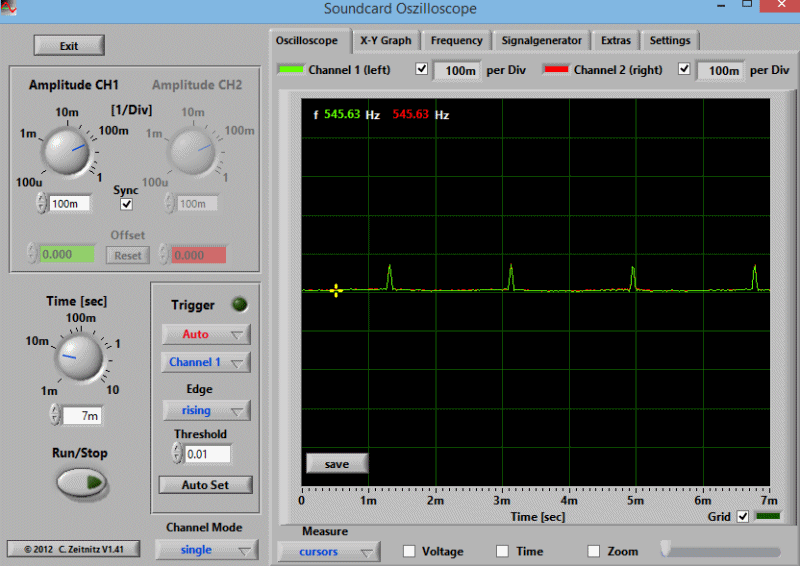
As you can see, there is a small reoccurring signal on max output, at 545 Hz. But watch what happens when you first start to dial down the control ring
RRT0se 14500 Near-Max:
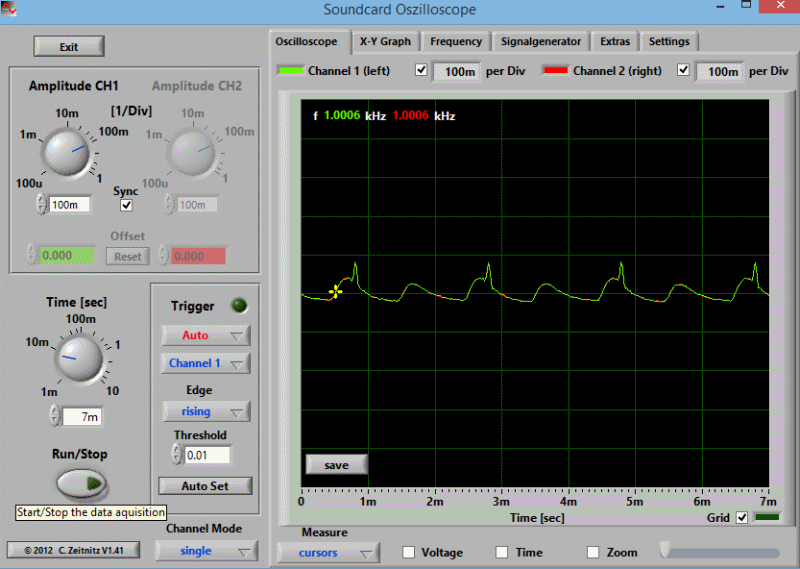
Now, a new sine wave-like harmonic appears at a reoccurring 1.0 kHz frequency. The 545 Hz signal is still present, superimposed over this signal (i.e., it looks like it is "riding" every other crest of the wave).
RRT0se 14500 Hi:

Quickly, this max signal disappears and we just left with a pronounced harmonic. This does not look like PWM yet.
RRT0se 14500 Med:
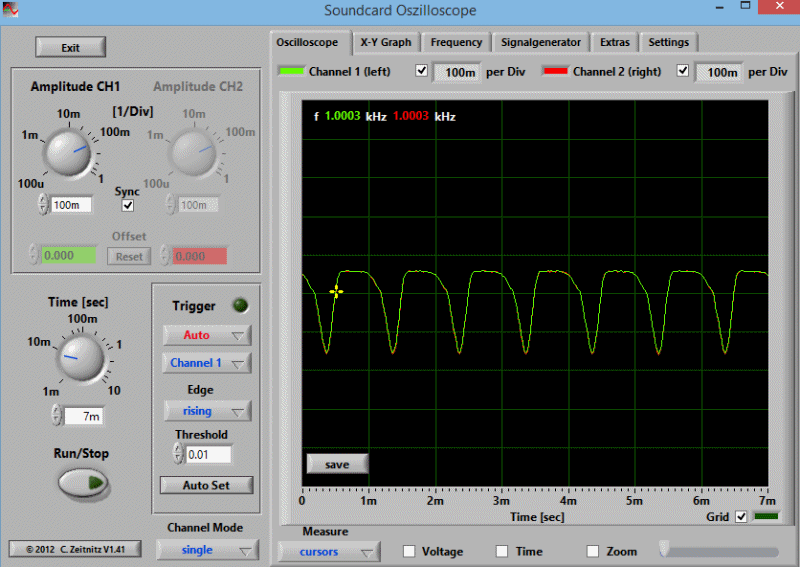
By the med level, the shape of the signal changes, suggesting a reduce on-time. However, this is still not the classic square-wave PWM pattern.
RRT0se 14500 Lo:
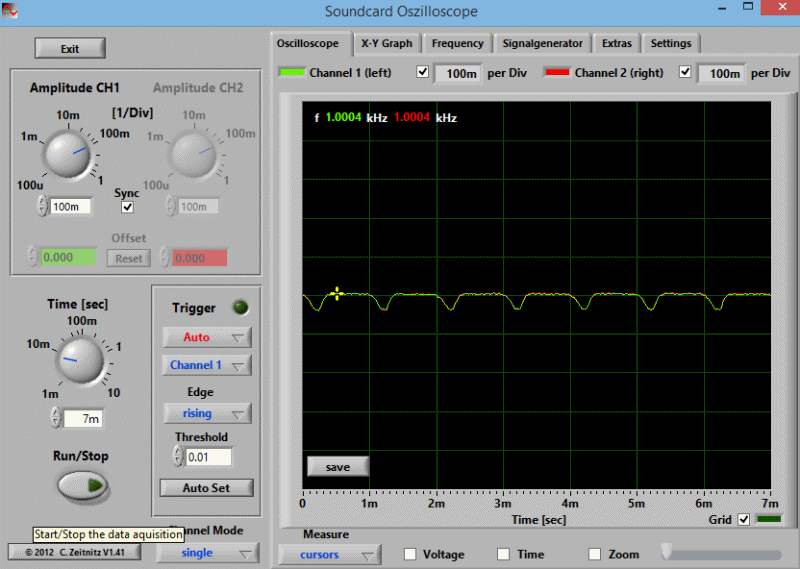
The on-pulse cycle seems further reduced, consistent with PWM.
And now for a lower voltage source:
RRT0se AA Max:
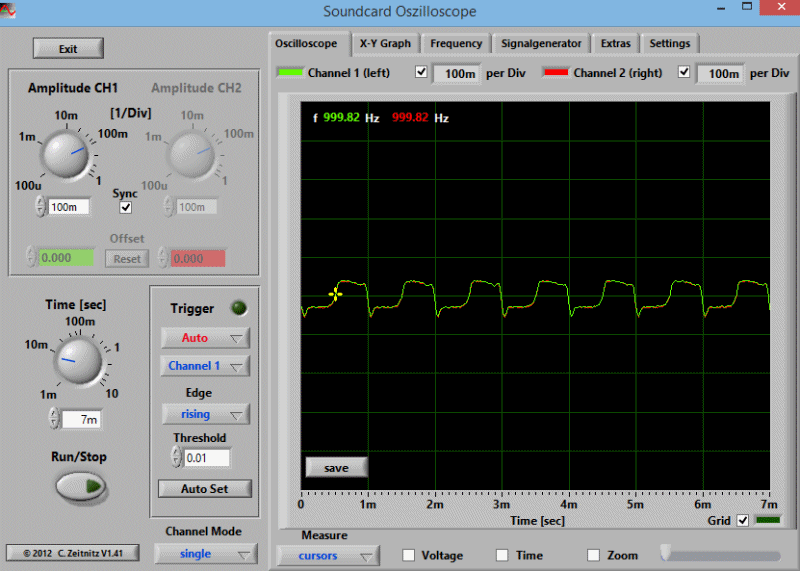
RRT0se AA Med:
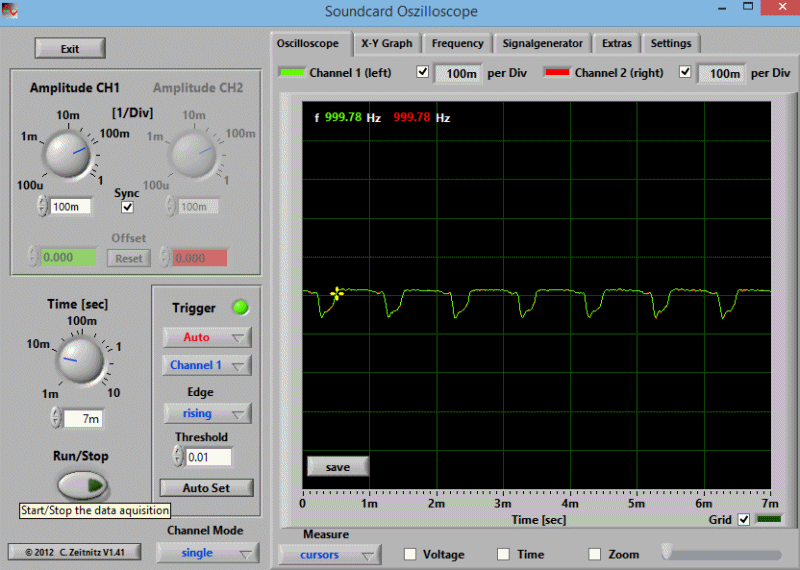
RRT0se AA Lo:

Ok, again, these are not the classic square-wave PWM signals that I am used to seeing. But there does seem to be a varying on/off duration (with constant frequency), consistent with a PWM control mechanism. I am guessing that there is some sort of additional filtering going on that is smoothing out the PWM on the oscilloscope pattern.
At the end of the day, the "flicker" from this PWM is pretty minimal, given the 1kHz frequency. I am quite sensitive to PWM and can see it in use, but I suspect most will only notice when shining on a fan or running water (or similarly fast moving objects).
Strobe:
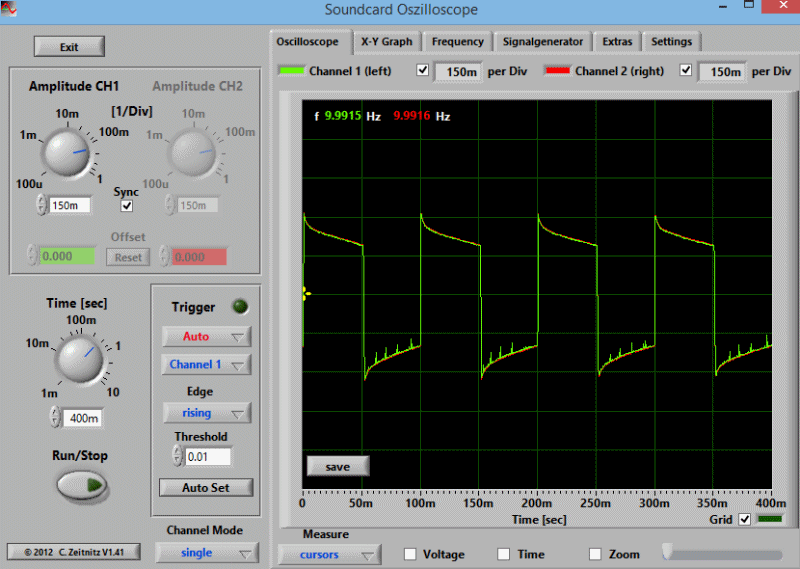
Strobe is a fairly typical fast strobe, of 10Hz frequency.
SOS:
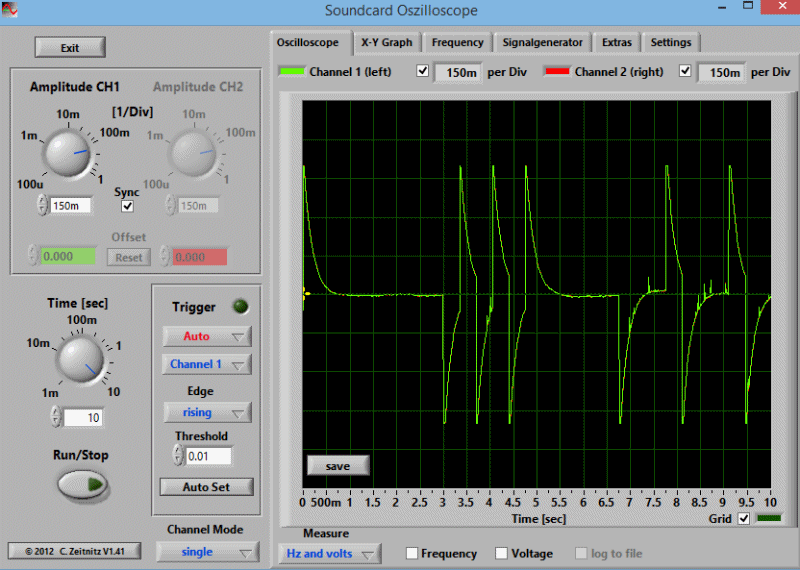
And again, a standard SOS pattern.
Standby Drain
Thanks to the physical clicky switch, there is no standby current when clicked off at the tailcap.
There is a standby off detent on the control ring however. When clicked on, I measured this initial current as 8.7mA on RCR/14500, 16.7mA on CR123A, and 36.9mA on AA. These are unusually high for a standby current, and would drain typical cells as follows: RCR/14500 (750mAh) in 3.6 days, CR123A (1400mAh) in 3.5 days, and NiMH AA (2500mAh) in under 3 days. As such I STRONGLY recommend you always store the light clicked off at the tailcap.
And as an aside, these numbers do not bode well for maximum runtime on each battery.
Beamshots:
For white-wall beamshots below, all lights are on Max output on an 3.7V Li-ion (RCR) battery. Lights are about ~0.75 meter from a white wall (with the camera ~1.25 meters back from the wall). Automatic white balance on the camera, to minimize tint differences.
1xRCR Comparison (note that I used a 14500 in these tests, as output is exactly the same as RCR)
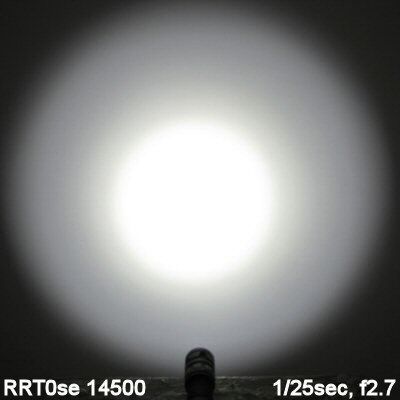
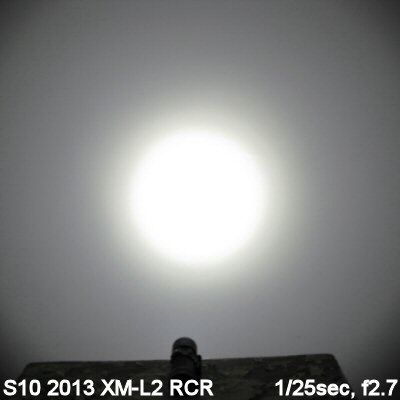
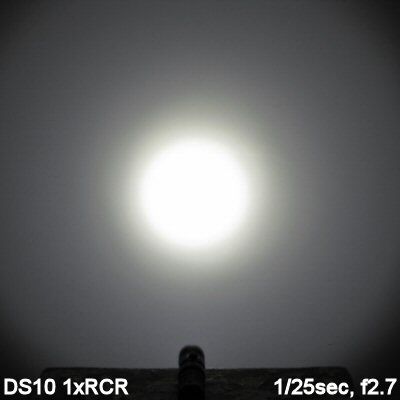
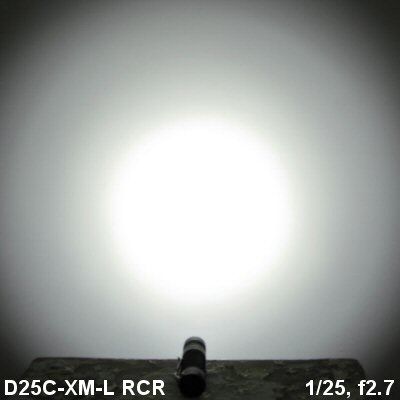
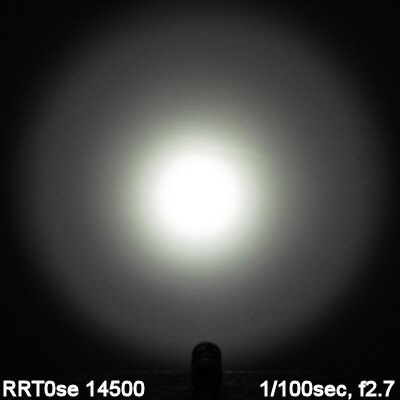
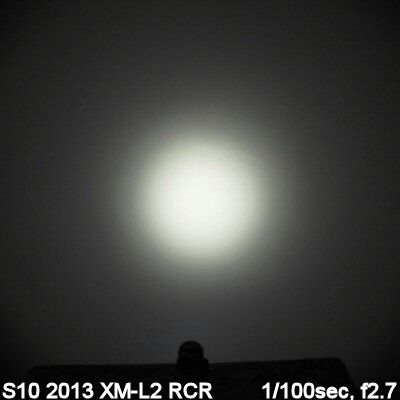
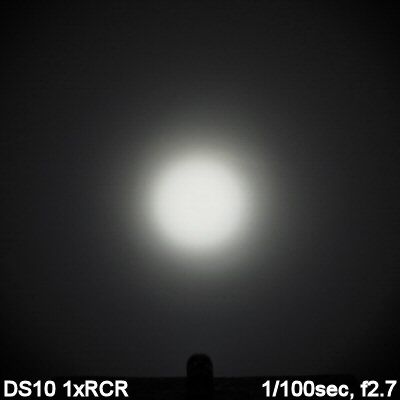
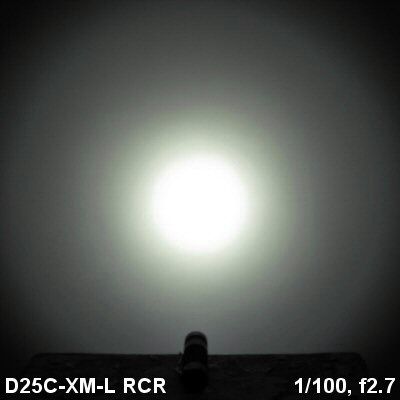
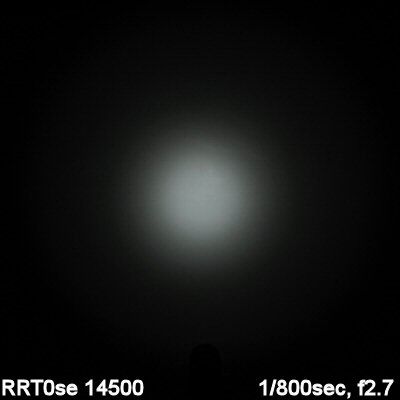
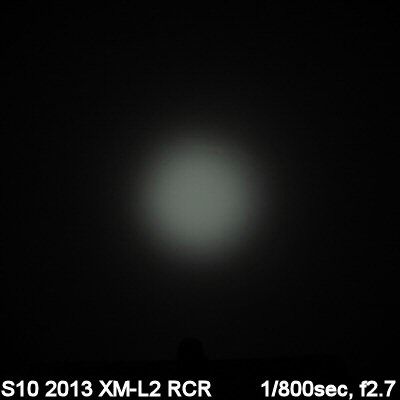
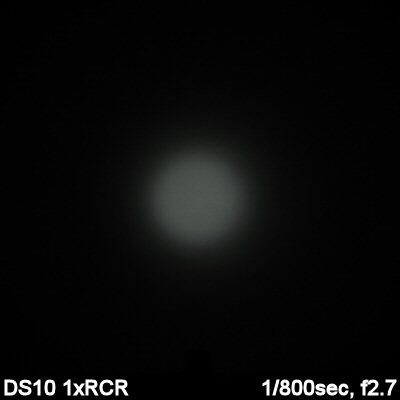
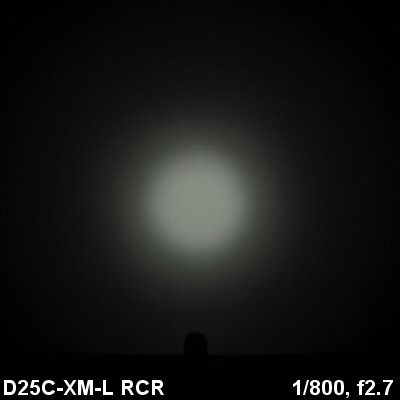
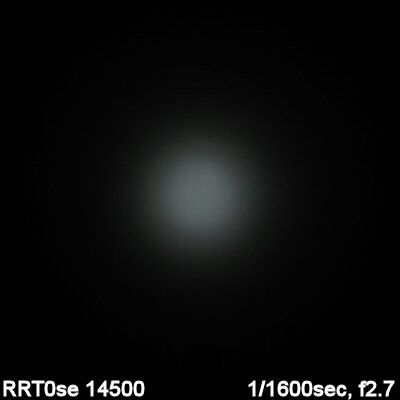
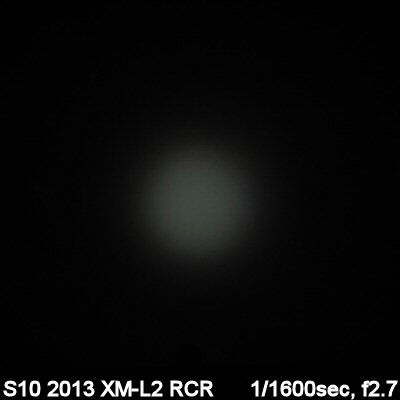
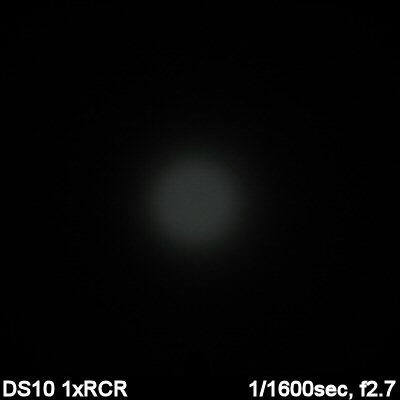
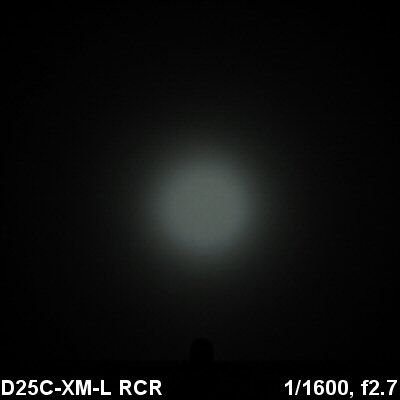
1xCR123A Comparison
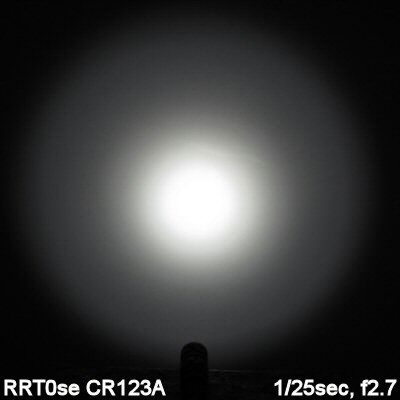
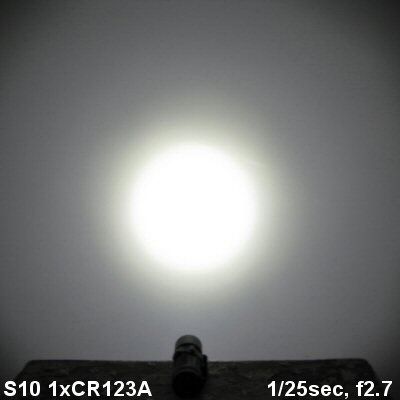
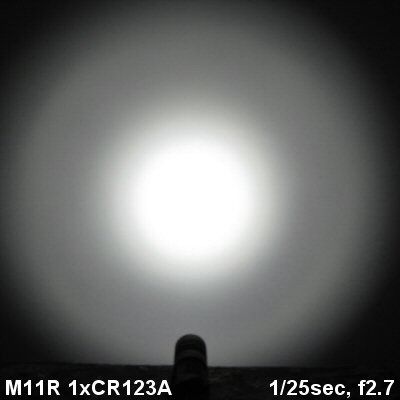
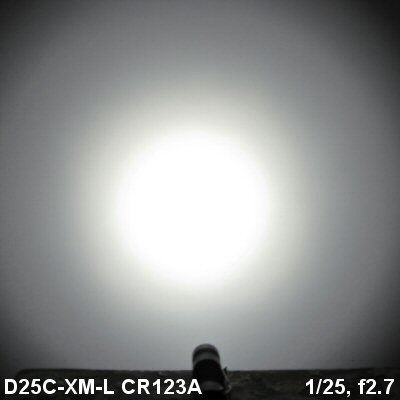
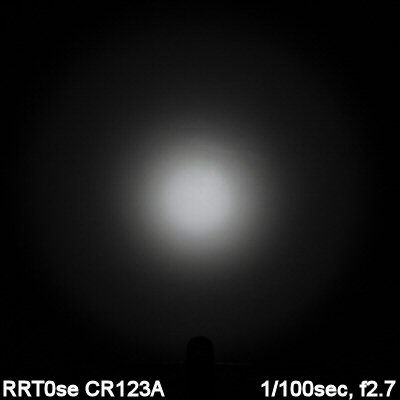
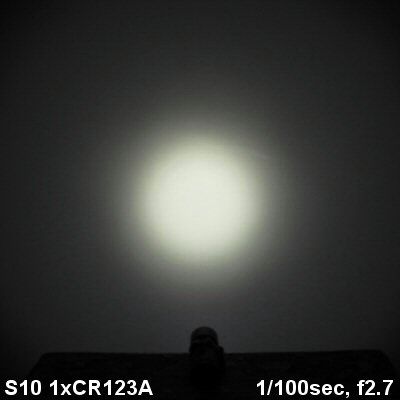
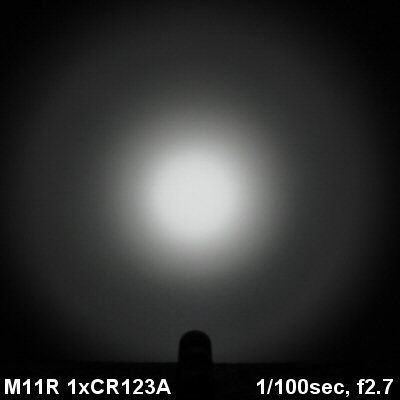
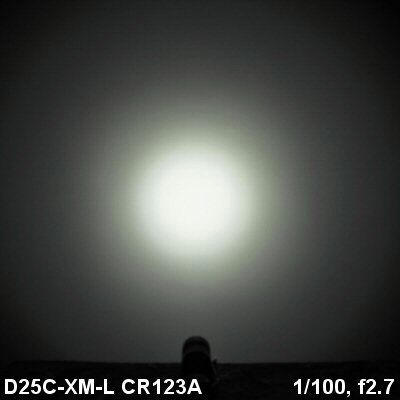

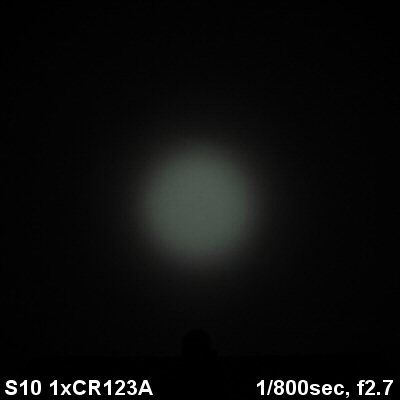
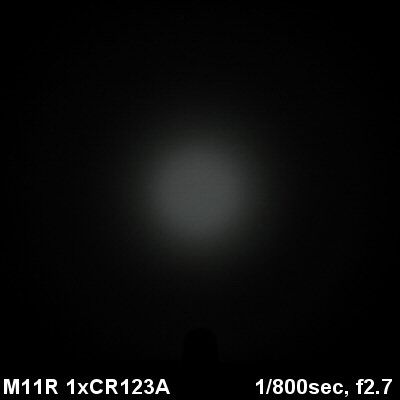
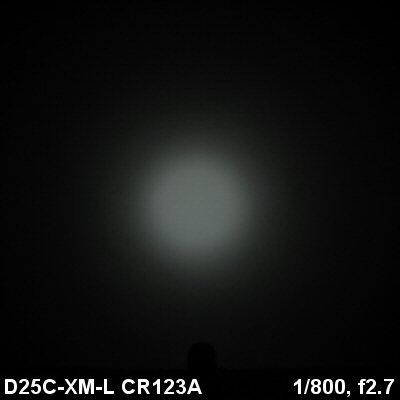
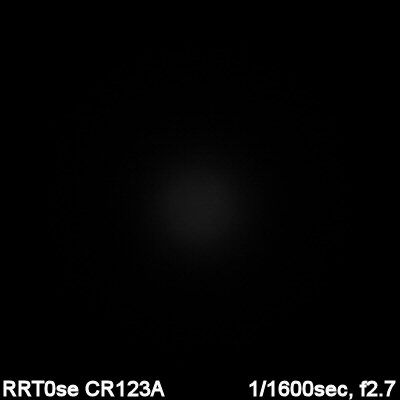
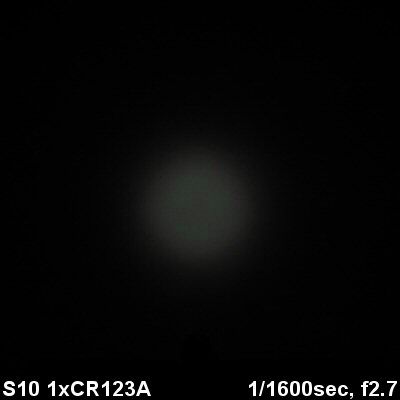
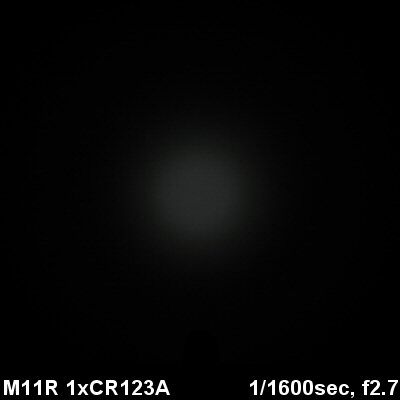
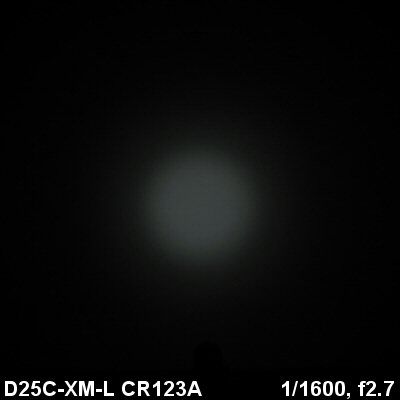
First thing you will notice is that max output is greatly reduced on the CR123A battery source. That's because I waited ~30 secs before taking this pics - initial output on CR123A is much higher (but not as high as RCR). Scroll down for discussion.
Testing Method:
All my output numbers are relative for my home-made light box setup, as described on my flashlightreviews.ca website. You can directly compare all my relative output values from different reviews - i.e. an output value of "10" in one graph is the same as "10" in another. All runtimes are done under a cooling fan, except for any extended run Lo/Min modes (i.e. >12 hours) which are done without cooling.
I have devised a method for converting my lightbox relative output values (ROV) to estimated Lumens. See my How to convert Selfbuilt's Lightbox values to Lumens thread for more info.
Throw/Output Summary Chart:
My summary tables are reported in a manner consistent with the ANSI FL-1 standard for flashlight testing. Please see http://www.flashlightreviews.ca/FL1.htm for a discussion, and a description of all the terms used in these tables. Effective July 2012, I have updated all my Peak Intensity/Beam Distance measures with a NIST-certified Extech EA31 lightmeter (orange highlights).
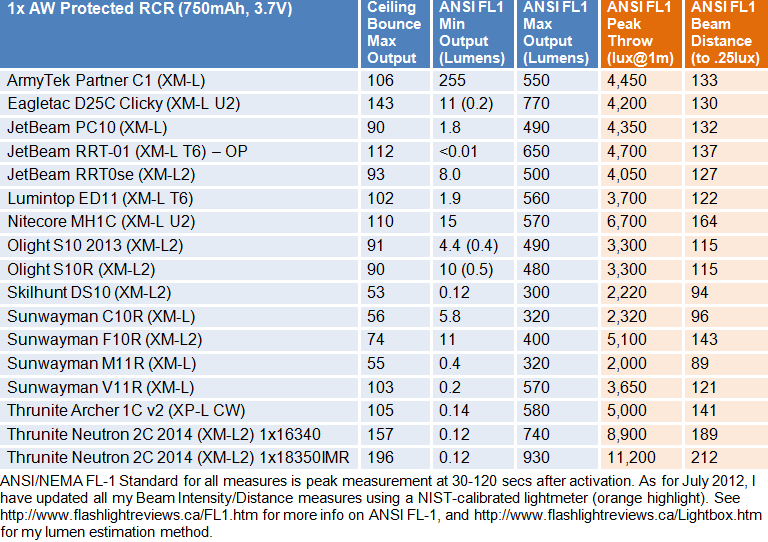
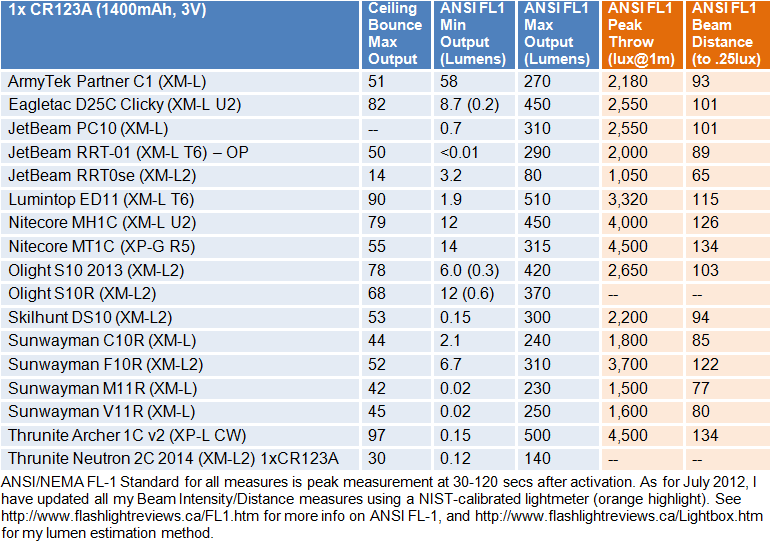

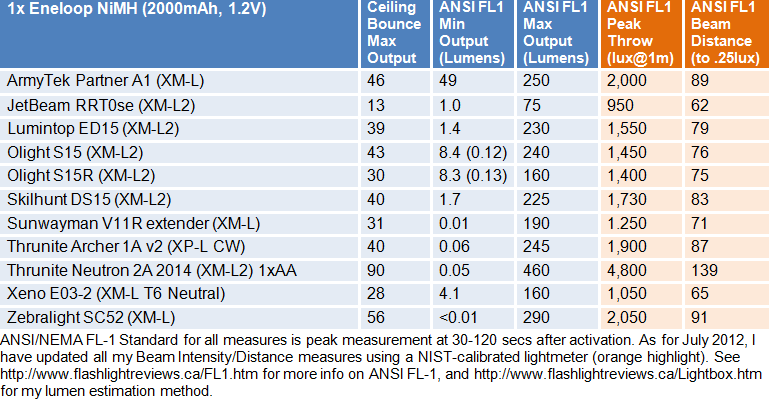
As usual with the recent Jetbeam lights, the stated max output spec ("730 lumens") doesn't seem very believable – the best that I found was ~500 estimated lumens, on 3.7V Li-ion sources.
The other issue is how the light handles lower voltage sources. As you can see above, max ANSI FL-1 output levels are a lot lower on CR123A/AA. Note that 3.0V CR123A is brighter initially (~300 estimated lumens), but my sample suddenly steps-down (usually within ~15 secs) to approximately match the level of 1.2V AA sources. I suspect that that this is an issue with my sample, as the time was variable when it jumped down to AA levels (i.e., sometimes it last longer, sometimes faster). I would have expected consistent intermediate performance between AA and RCR/14500 at around this ~300 lumen level.
Also, the minimum output levels are a bit disappointing, at ~8 lumens on 3.7V Li-ion. I would have liked to have seen true moonlight/firefly modes.
Let's check out the runtimes to see what is going on.
Output/Runtime Graphs:
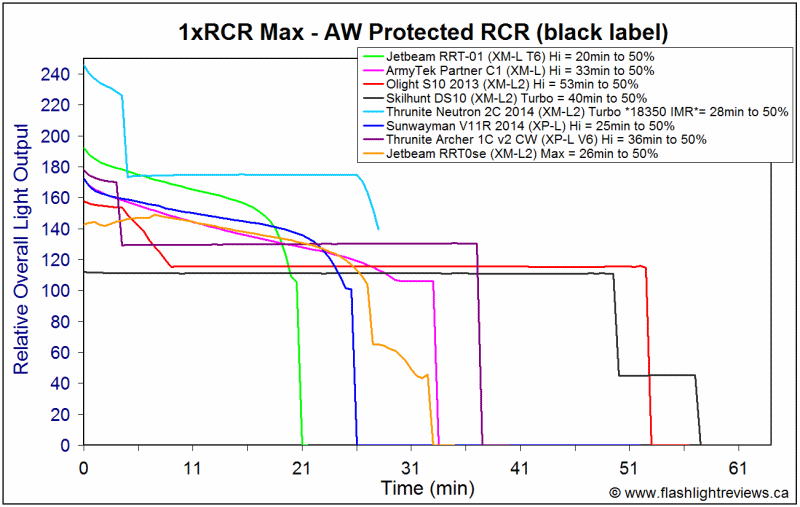
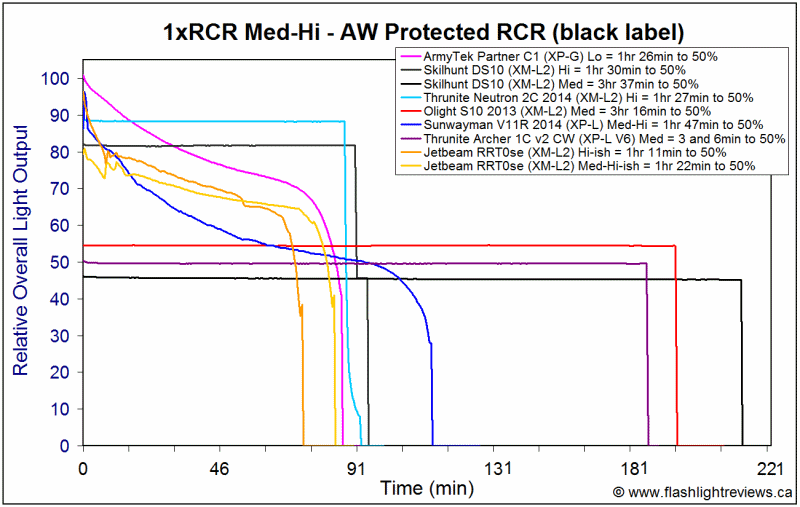
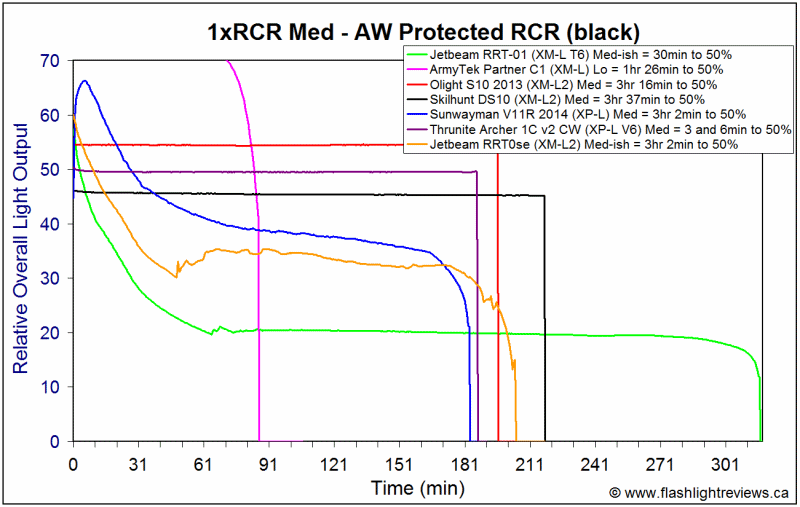
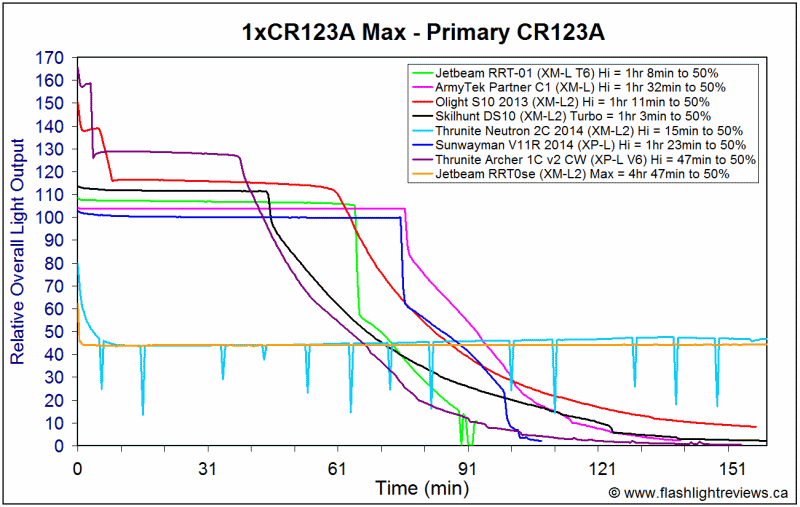
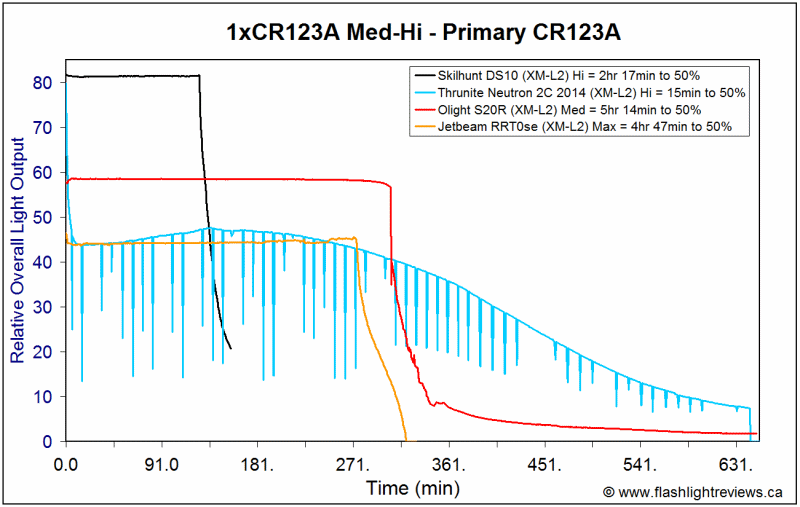
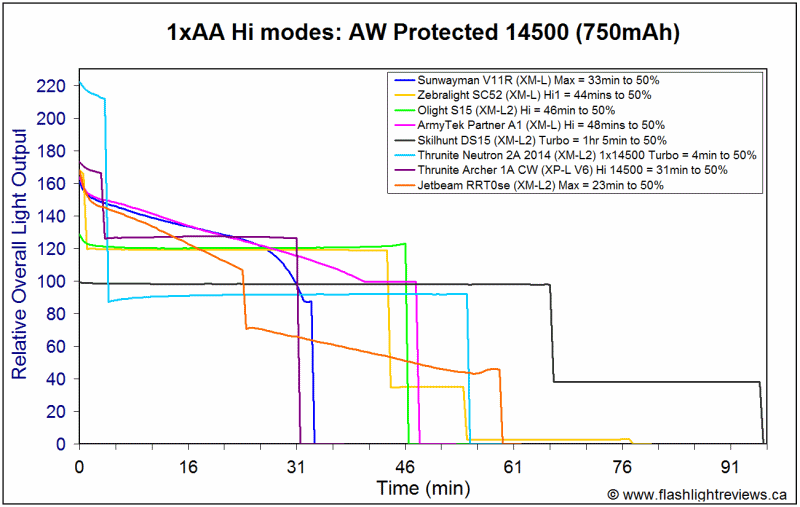
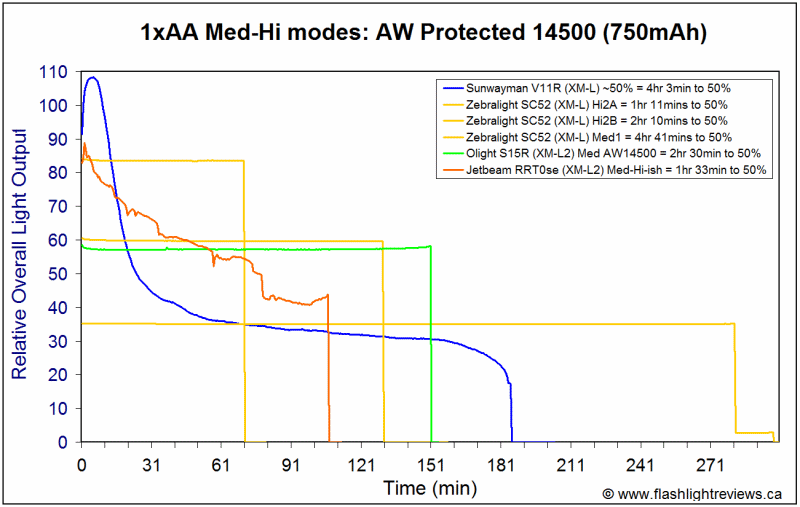

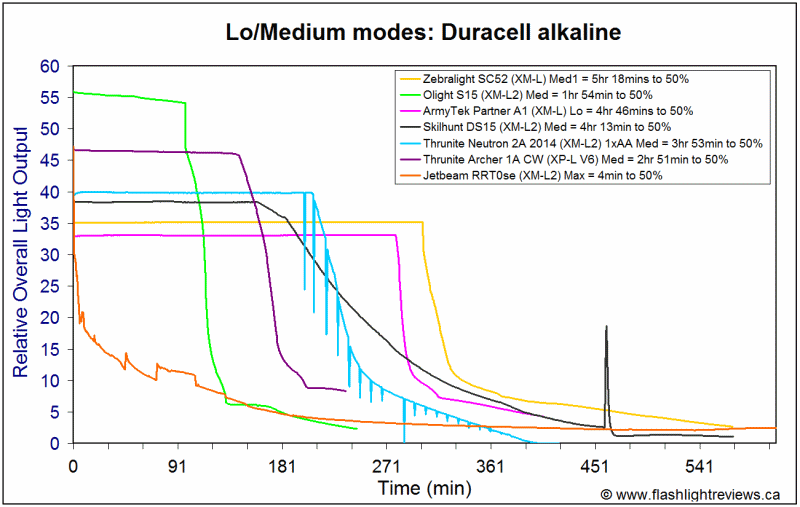
First the good news – at least at the higher outputs, overall efficiency seems very similar to the Sunwayman V11R. The RRT0se even shows similar "output drift" issues over time). But the RRT0se shows a somewhat "noisier" regulation pattern, with small changes in output occurring on most modes over time.
It is also disappointing to see the fairly low max output on AA/CR123A. The CR123A issue is one I suspect is specific to my sample, as it should produce be able to consistently keep its ~300 lumen max initial high level without drop-off to AA levels. :shrug: I tried various brands of CR123A, with no difference – all drop down within the first minute of testing.
In any case, the ~80 lumen max level for AA is also low. The RRT0se is really a light to be used on 3.7V Li-ion sources if you want to get the full range of features.
Note as well that although I don't test min outputs (for max runtime), don't expect much more than what you are seeing reported above. There is a high overhead current on the circuit, limiting long-term runtime (see the Standby Current section above).
Potential Issues
Although the RRT0se has a physical tail switch, there is a standby off detent on the ring that requires a stand-by current. This current is high, and will drain all types of batteries within a few days. The high overhead means that max runtimes are also limited to under a couple of days as well.
Similarly, minimum output is higher than most lights with variable control rings (i.e., ~8 lumens min, on 3.7V Li-ion). I would have preferred to see true Moonlight/Firefly modes (with lower currents).
The RRT0se is only able to produce the widest range of output on 3.7V Li-ion sources (i.e., RCR/14500) – and even these are well below the rated specs, at ~500 estimated lumens. On AA, you are limited to a max output <100 estimated lumens. On CR123A, you get initially an intermediate ~300 lumens on max – although my sample consistently steps down to the AA <100 lumen level within seconds, on all brands of CR123A that I have tried.
The RRT0se uses some form of filtered PWM at all levels, at a visually detectable 1kHz. This is high enough as to not be distracting in actual use (although some may be more sensitive to it than others).
Overall output/runtime efficiency is similar to competing PWM-based lights with comparable features, but the RRT0se shows a less consistent regulation pattern.
The control ring does not appear to use a "visually-linear" ramp of output, but rather a circuit-linear ramp (i.e., the light subjectively appears to have a lot more relatively higher outputs than lower ones).
Physical build quality – while still acceptable – is reduced from earlier RRT series JetBeam lights. In particular, I notice the very gritty screw threads throughout, and the feel of the control ring (i.e, a mm or two turn out of the standby detent is required before light is produced).
Preliminary Observations
Having been a long-time reviewer of Jetbeam lights, I am somewhat disappointed to see how this sample performs – both compared to earlier Jetbeam lights, and competing current products in the convertible AA/CR123A class. :shrug:
To be clear, the RRT0se is still a reasonable light with a decent feature set. The ability to switch between CR123A/RCR and AA/14500 is very welcome in the pocket EDC category. And I personally like the look of the RRT0se, especially its dark natural finish. But overall performance and build quality are not up to the earlier Jetbeam lights – or the competing Sunwayman V11R and Nitecore SRT3.
In terms of output, the RRT0se does not meet its rated "730 lumens" spec (a consistent over-statement that I've noticed across all the recent Jetbeam "se" lights). While the true ~500 max lumens here is still quite reasonable for 1xRCR/14500, it is disappointing that CR123A and AA are so much lower (i.e., it produces only ~80 max lumens in my testing on these sources). It's true that fresh CR123As do start at an intermediate ~300 max lumens in my testing (as I would have expected). However, my sample always drops down to the AA level of <100 lumens very quickly. Ultimately, this low performance really limits the broad usefulness of supporting multiple battery sizes in the first place. :sigh:
While overall output/runtime efficiency (at higher outputs) is similar to the competing lights, my RRT0se shows less consistent regulation (i.e., a more "noisy" pattern). It also has a higher circuit overhead than the competing lights, limiting maximum runtime available here. The RRT0se doesn't go to as low in min output as the V11R or SRT3 either.
Unfortunately, the RRT0se has a visible PWM-like signal at all levels, although at a reasonable 1kHz. Still, this is disappointing given the lack of any PWM flicker whatsoever on the competing V11R or SRT3.
Beam pattern is what you would expect for a light of this size and class. There are no obvious artifacts on my sample.
At the end of the day – and based on comparable MSRP - I really can't see why anyone would choose to go with the RRT0se over the V11R or SRT3 (which have been available for 3 and 2 years now, respectively).
----
RRT0se was supplied by GearBest.com for review.
Last edited:


 ,i love the form,infinite control,like you the colour as well. Various cell options,all going for it(price is on high side at retail as you state,would not pay that) then .............:sigh: Could it be possible a faulty sample? I was pretty much sold on this light just by the pics and specs..........
,i love the form,infinite control,like you the colour as well. Various cell options,all going for it(price is on high side at retail as you state,would not pay that) then .............:sigh: Could it be possible a faulty sample? I was pretty much sold on this light just by the pics and specs.......... Thanks for the catch.
Thanks for the catch.